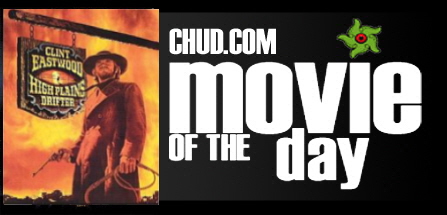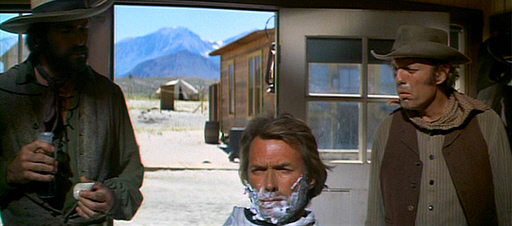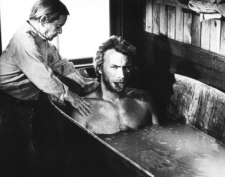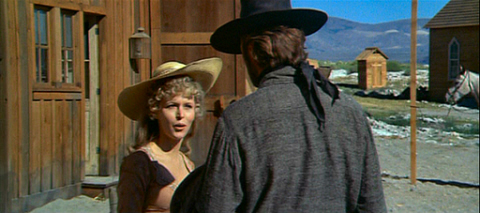
The Film: High Plains Drifter (Buy it from CHUD)
The Principles: Clint Eastwood (director/star), Verna Bloom, Marianna Hill, Billy Curtis, Stefan Gierasch, Jack Ging, Mitch Ryan, Geoffrey Lewis
The Premise: The quaint, Californian town of Lago is shaken when a stranger rides in. After dispatching the town’s three protectors in a gunfight, The Stranger is looked at as Lago’s new savior – asked to protect Lago of an impending attack from outlaws Stacey Bridges and the Carlin brothers. He agrees, only if the town provides him anything he wants. We soon learn there’s more to this Stanger than we first thought, and his presence is linked directly with the slaying of Lago’s former Marshall.
Is It Good: Very. But let’s set that aside for a moment. Given Eastwood’s recent contributions to the political climate, it’s perhaps the perfect film to view through a politically-skewed lens. Clint hasn’t always been such a staunch supporter of republican ideology and, truth be told, he’s classified himself as a libertarian for most of his career. He’s even gone so far as to criticize our conflicts in both Afghanistan and Iraq. But, especially given recent events, it is fair to say the man leans right.

So too does The Stranger of High Plains Drifter – perhaps the most right-leaning film of Clint’s directorial career. Let’s see what we can infer regarding The Stranger’s belief-set based on his own actions in the film:
- Second Amendment Rights: Gun use is the only thing liberal about this character. He’s not in the town a full ten minutes before he dispatches three miscreants. The ability to carry-and-conceal is something he values, as he hides his gun under a barber’s drape before he fires.
- Less Government: Literally. Once the city guarantees him everything he wants, one of his first orders of business is to remove the current mayor and fill the seat with Mordecai, his friend and confirmed little person.
- Capital Punishment: The Stranger believes firmly in the death penalty. As he enacts vengeance on those who’ve committed wrongs against him under pain of death.
- Foreign Policy: Threats from the outside world will not be tolerated. As an outlaw invasion looms, The Stranger (an invader in his own right) coordinates the town into a dangerous defense unit. Our Stranger literally paints the town red (also the color of our most severe threat level under the most recent Bush Administration) and trains the citizens in all manners of defending themselves. And when the battle ends? He simply rides out of town, leaving a red town and high bodycount in his wake.
In his second film, Eastwood set out to make a tribute of sorts to acclaimed western directors Sergio Leone (The Good, The Bad & The Ugly) and Don Siegel (Dirty Harry). In this regard, he succeeds brilliantly. Drifter manages the tone of Leone’s spaghetti westerns with the hard-nosed cynicism of Siegel’s Harry (they also worked together on the much friendlier Two Mules for Sister Sara).
 But in doing so, Eastwood creates a character that’s something of a philistine. Apart from the above listed political analysis, The Stranger commits forcible rape on a woman in one of the most uncomfortable acts a “hero” has ever committed on film. Even as anti-hero, there’s no real atonement for this act in the film; in fact it’s implied that, in turning a blind eye at the aforementioned Marshall’s murder, the town deserves such treatment from The Stranger.
But in doing so, Eastwood creates a character that’s something of a philistine. Apart from the above listed political analysis, The Stranger commits forcible rape on a woman in one of the most uncomfortable acts a “hero” has ever committed on film. Even as anti-hero, there’s no real atonement for this act in the film; in fact it’s implied that, in turning a blind eye at the aforementioned Marshall’s murder, the town deserves such treatment from The Stranger.
Obviously, I’m not a moralist when it comes to my art. I also don’t believe Eastwood set out to create a character that was both his most conservative as well as his most barbaric. But the subtext is undeniably there. In many ways, High Plains Drifter serves as a precursor to the Reagan-era action films of the 1980s like Rambo (First Blood II) or Commando –a time where conservative ideologies were more comfortably acknowledged and reflected in film. Reagan may have publically empathized with John Rambo, but The Stranger’s ideologies predate his like-minded presidency by eight years.

Is it worth a look: Of course. Listen, when I knew this was going to be my MOD I chose to approach it from a political standpoint. But the film works on a variety of levels and, above everything, it’s just a really solid, American-made western. Removed of its subtext, it would surely have lost some of its bite and this is the kind of flick that needs teeth if it’s to be effective. This film continued the trend of harsher action fare. For its time, I don’t think Eastwood could have chosen two better masters to ape than Leone and Siegel.
Also worthy of note, this is one of Eastwood’s leanest films. His acute directorial awareness is present and free of any predisposition to plodding running times and slow-burn dialogue – something commonplace in later works.
Random Anecdotes: My father first showed me the film at the young age of seven. “What’s it called?” I asked. “Paint The Town Red.”
It’s been twenty years, but I just recently remembered to correct him on this mistake.
Cinematic Soulmates: The Dollars Trilogy, Two Mules for Sister Sara, Dirty Harry, Karate Bullfighter